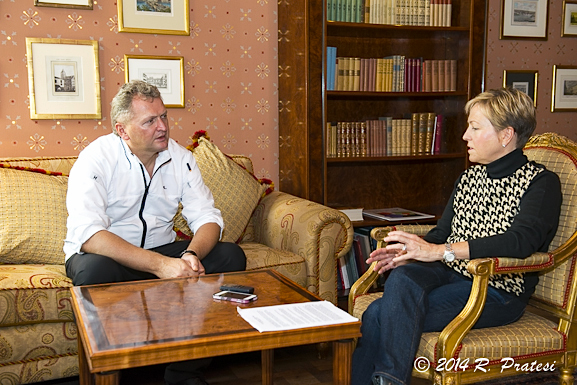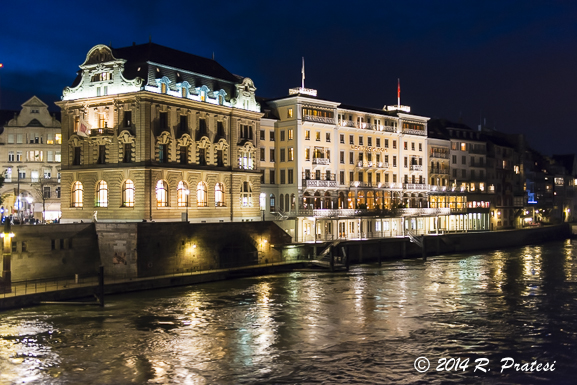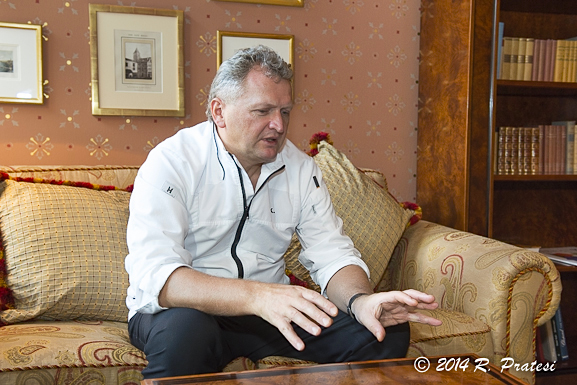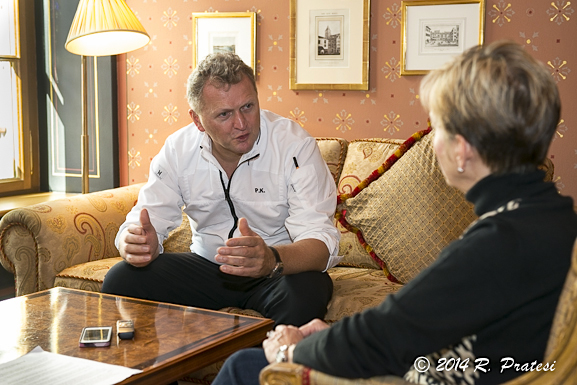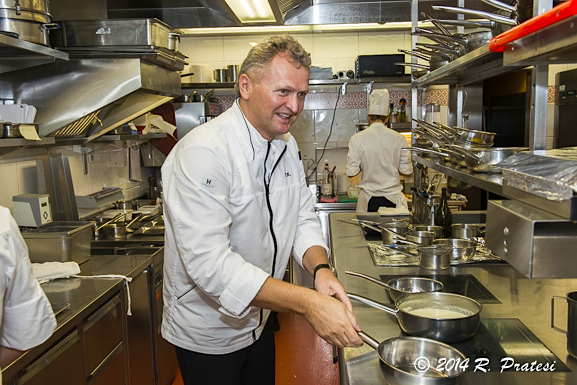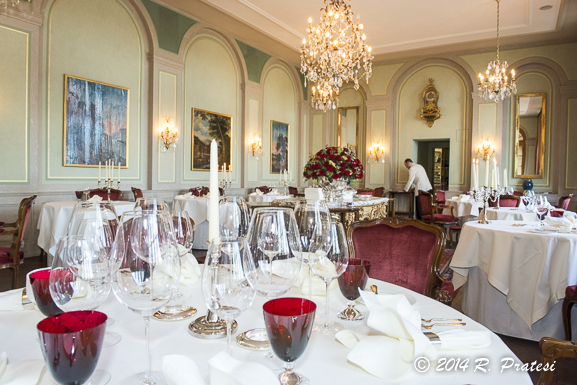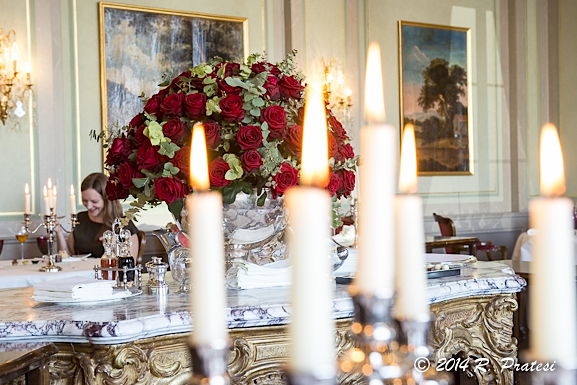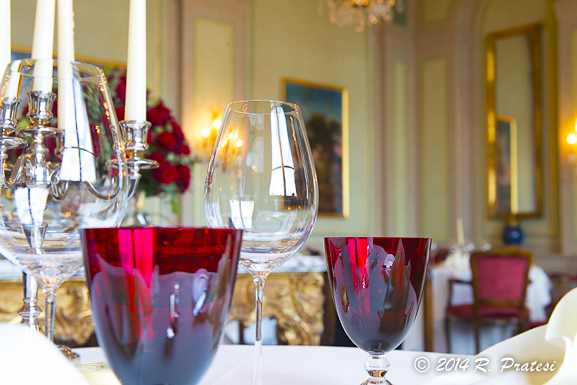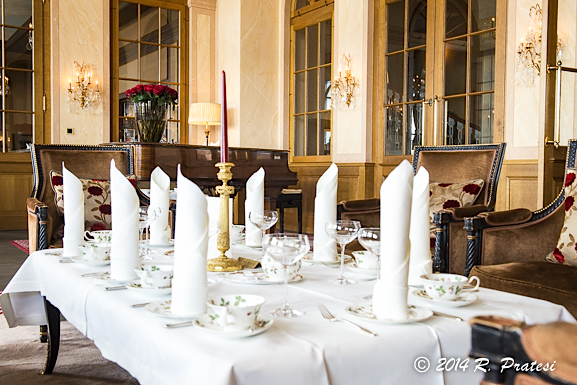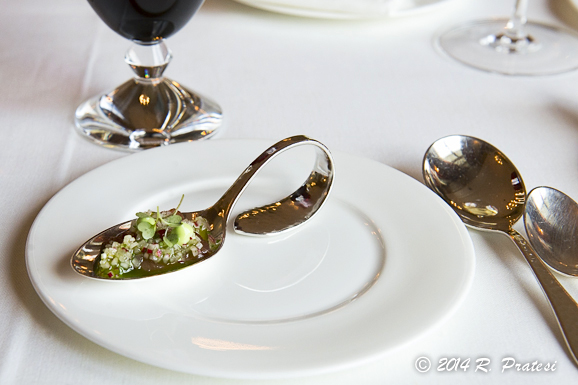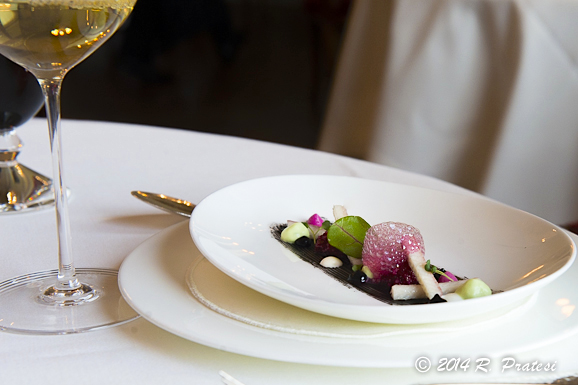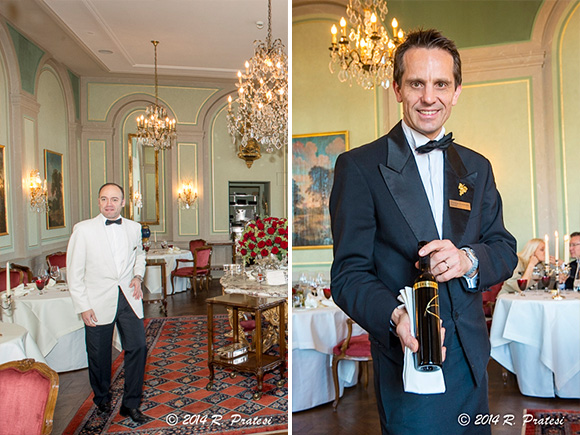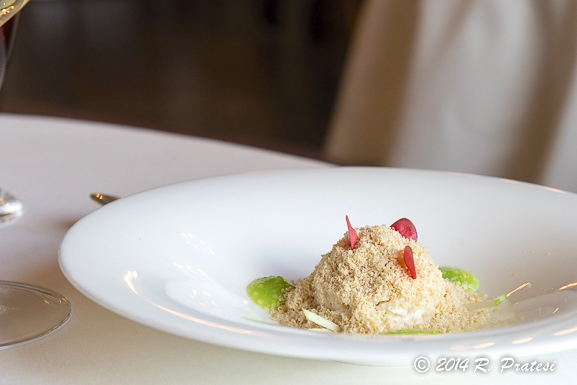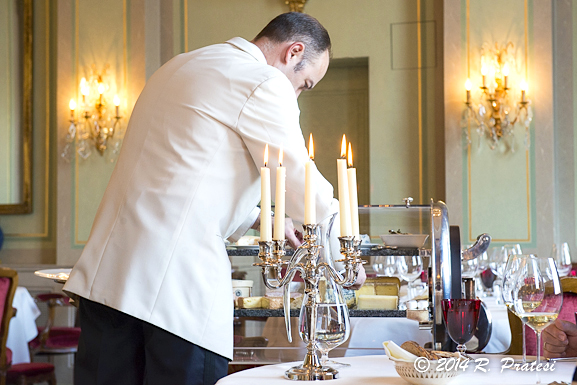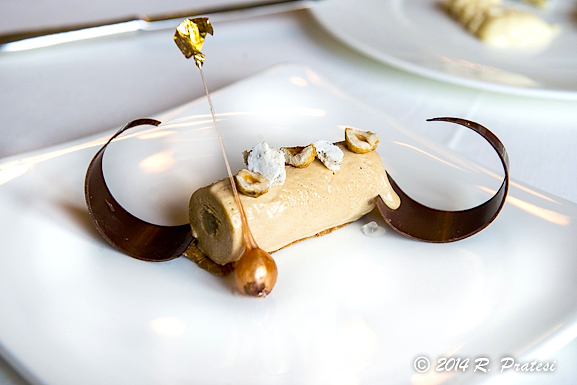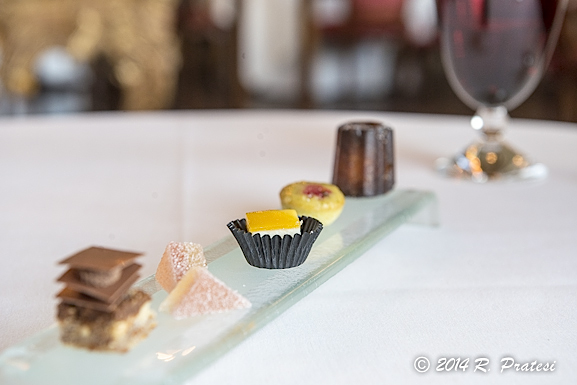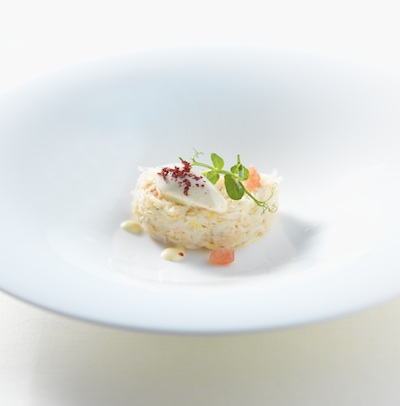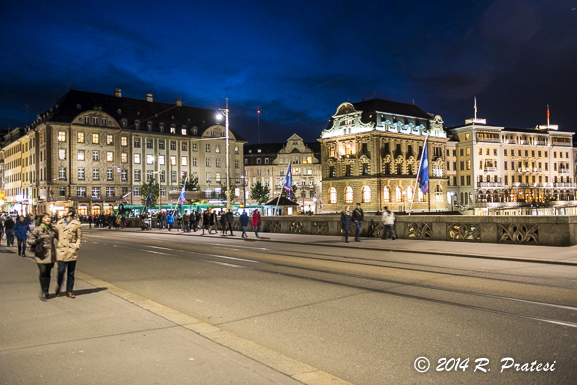Chef Peter Knogl – Cheval Blanc at Grand Hotel Les Trois Rois in Basel, Switzerland

The chef makes the kitchen. The kitchen is about emotion. ~ Chef Peter Knogl
As we entered the upstairs library at the Grand Hotel Les Trois Rois with Peter Knogl, Chef de Cuisine of the two-Michelin starred restaurant Cheval Blanc, he remarked about the recent death of Charlie Trotter. Chef Knogl was gracious and welcoming and as he motioned for us to sit down, he said, “The life of a chef is not long. It is stressful.”
After understanding more about the process of being awarded a Michelin star, or a macaron as it is called in France, my interpretation of the word “stressful,” as it relates to chefs, has new meaning.
For those of us living in the United States and working in the culinary or hospitality business, the James Beard Awards, “The Oscars of the food world”, as they are known, may be a more familiar name in the awards arena. Michelin stars are only awarded in a small number of cities in the U.S.: New York, Chicago, Los Angeles, Las Vegas, and Napa Valley, California. What started as a marketing tool for the Michelin Tire Company in France in 1900 by brothers André and Édouard Michelin, the guide originally listed places to stop for gas while traveling. By 1926, the red jacketed Michelin Guide had evolved into a restaurant guide for several countries in Europe, awarding stars for a fine dining experience.
In 1936, realizing how popular these guides had become, Michelin published its rating system of one to three stars with the following criteria:
- One star – A very good restaurant in its category (“Une très bonne table dans sa catégorie”)
- Two stars – Excellent cooking, worth a detour (“Table excellente, mérite un détour”)
- Three stars – Exceptional cuisine, worth a special journey (“Une des meilleures tables, vaut le voyage”)
What was once a simple guidebook recommending places to stop for good food, is today the gold standard and most prestigious award for chefs and restaurants around the world, particularly in Europe. Being awarded a Michelin star is the pinnacle of culinary excellence. Judged anonymously and often, many times by different Michelin inspectors over the course of a year, it is all about the food at a Michelin star restaurant; every element of the dish has to be executed with perfection and precision and it needs to be consistent.
Chef Knogl is no stranger to the world of Michelin stars and culinary excellence, having earned Michelin stars in his prior restaurants. Born in Bavaria on the border of Austria, Knogl had a culinary apprenticeship for three years in Bavaria and then immediately went to work in some of the finest restaurants and properties in Germany, Spain, France, London, and Switzerland. Most held Michelin stars or were five star establishments. Knogl worked several years with Heinz Winkler, whom he considers his mentor. Winkler, whose Relais & Chateau property is in Aschau im Chiemgau in Bavaria, has been awarded the ultimate three Michelin stars an impressive twenty times.
Arriving in Basel in 2007, Knogl was awarded a Michelin star for his cuisine at Cheval Blanc just seven months in to his tenure and received his second Michelin star the following year. He has retained that status ever since. Knogl was also named “Newcomer of the Year 2009” and “Chef of the Year 2011” by the Gault Millau Swiss restaurant guide and Cheval Blanc has been awarded 18 Gault Millau points by the influential guide.
Being responsible for Cheval Blanc and the entire staff at the restaurant, Knogl’s focus is to be the “Chef of the restaurant.” He told us, “It’s too much to be an executive chef of the hotel. I know hotels and have done that. I want to focus on gastronomy. I want to cook and be responsible for my staff. It needs to be managed like an island with one concept, not five concepts.” He went on to say, “Create a good concept, get it right, and perform it well. That’s excellence. It’s not good to change the concept every year. If it’s not working after two to three years, then change. It takes time. If you make the investment, it will come back to you.”
As an incredibly focused and talented chef with a passion for creating extraordinary dishes, we wanted to know a bit about his personal life. “If you are a Michelin star chef there is no family time. I never married. I travel a lot. That’s the life.” While many chefs have chosen to get married and have children and juggle the long hours at the restaurant and stress along with a family, Knogl has decided that it’s just too hard to excel at either when you have both responsibilities. It’s more important to him to be excellent in the kitchen.
With inspiration from his world travels and a fondness for Spain, most recently, San Sebastián in the springtime, his focus is on sourcing only truly exceptional products and achieving harmony on the plate. “It’s not a picture show. The product and combination of flavors have to be in harmony; if there’s lobster in the dish, you have to taste the lobster, not ten other ingredients. You have to feel the product and taste the product. Each chef creates a different story and different taste. The effort is hard work, but it cannot just be a picture.”
“Everything (the ingredients) has a high point. You have to anticipate it. Like a sauce; it needs to go on the plate right then. You can’t wait. It’s very important to get all of the ingredients at their high point and to put them on the plate at the same time. If the picture looks fantastic, that’s good, but that is twenty-five percent of the dish. The product and taste have to be seventy-five percent. Many people are doing the reverse and it’s just for show.”
With such precision and emotion that goes into each plate that leaves Cheval Blanc’s kitchen, we asked how often the menu changes. “We change about fifty perfect of the menu each season and I change some dishes every four weeks, depending on the quality of the product. People return because they enjoyed a dish, so you can’t change everything, especially if they come two times a week. When I have an idea for a new dish, we test it in the kitchen and if it’s good, we make it for lunch and then we’ll put it on the dinner menu.”
When asked where to look for the next trend in great cuisine, Chef Knogl immediately said, “Holland. That is the future. You need to go there. The Dutch chefs are very creative and they have a great mentality about work, just like the Germans. They are highly motivated.” With a growing list of Michelin-starred restauarnts, The Netherlands is no longer known for just cheese and herring and is gaining international recognition for its innovative cuisine. And what about France and Italy, two countries who have long been known for their Michelin star fame? “It’s about the mentality of having good food; the atmosphere and the language together. It’s more about the show and experience now. It’s not like it was twenty-five or thirty years ago. They are losing a lot.”
So, on a Saturday afternoon in this beautiful historic hotel along the Rhine River, we dined at Cheval Blanc for lunch. With views of the river from our table situated next to the window and the elegant atmosphere of this stunning dining room surrounding us, we enjoyed several of Chef Knogl’s favorite new dishes and some that he’s most proud of: Smoked eel, beetroot, black garlic and wasabi; Crab, grated goose fois gras, and green apple; and Crispy filet of red mullet with saffron, black garlic and vinaigrette of tomatoes. With impeccable service by Maitre d’hôtel Grégory Rohmer and the waitstaff and excellent regional wine pairings selected by Sommelier Christoph Kokemoor, this is a team effort orchestrated to create an extraordinary experience for the guest. Throughout the afternoon, the concept of Knogl as the “Chef of the restaurant” became apparent.
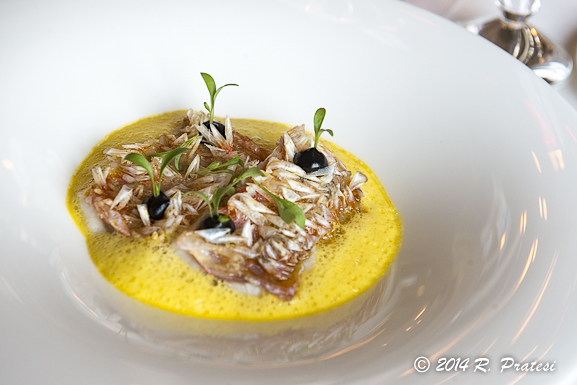
My favorite dish – Crispy filet of red mullet with saffron, black garlic, and vinaigrette of tomatoes
With a staff of eight in the kitchen (with two of those being pastry chefs), and the maximum number of seatings at thirty, a meal at Cheval Blanc is a most memorable experience and a privilege. As we tasted each of the dishes, the earlier discussion we had with Chef Knogl about the importance of the feel and taste of the product played over in my mind. These refined dishes were the chef’s canvas where he combined brilliant colors, beautiful product, and creative preparations to tantalize the eyes and the palate with extraordinary flavors and the harmonizing of the ingredients. While it was art in appearance, it was all about the product and the taste.
We thank Chef Knogl for his hospitality, the time he spent with us, and insight. It was a pleasure to meet him while we were in Basel. Translated from German to English, Chef Knogl has shared his recipe for Taschenkrebs mit Yuzu-Mayonnaise und Senf-Eis or Crab with Yuzu Mayonnaise and Mustard Ice Cream. With an intriguing combination of flavors and textures, you can try your hand at Michelin star cuisine at home.
For more information on Basel and the Grand Hotel Les Trois Rois, please refer to this article.
This content is protected under International Copyright Laws. Bunkycooks provides this content to its readers for their personal use. No part (text or images) may be copied or reproduced, in whole or in part, without the express written permission of bunkycooks.com. All rights reserved.
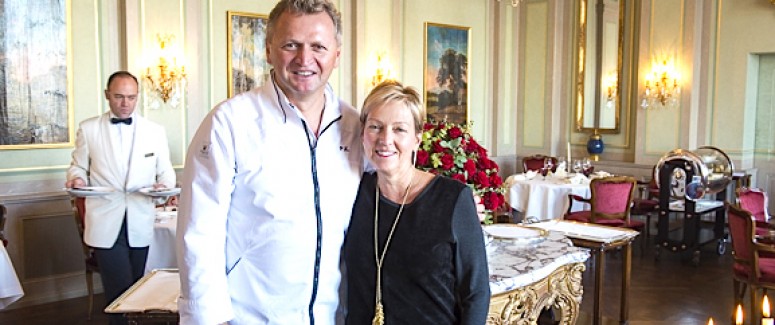
Crab with Yuzu Mayonnaise and Mustard Ice Cream
This recipe was translated from German, so most of the measurements are in metric.
Ingredients:
For crab:
1 egg yolk
1 teaspoon Dijon mustard
200 ml of sunflower oil
Salt
1 teaspoon yuzu juice (Japanese citrus fruit)
100 grams crab meat
For Mustard Ice Cream:
50 ml cream
250 ml milk
1 teaspoon sugar
2 1/2 egg yolks
15 grams of glucose (commercially available)
2 grams of stabilizer (commercially available)
40 grams Pommery mustard
2 drops of Tabasco
1 pinch of salt
1 dash of Chardonnay vinegar
For assembly:
4 grapefruit fillets, cut into small cubes
Yuzu mayonnaise
4 Cress sprouts
Pink peppercorns, coarsely ground from the mill
Directions:
Method
For crab:
Combine egg yolk and mustard in a bowl and whisk in the sunflower oil until it becomes the consistency of a mayonnaise. Season with a little salt and yuzu juice. Reserve a little of the mayonnaise to garnish the plates. Fold in the crab meat to the remainder of the mayonnaise and mix well. Cover and refrigerate or alternatively (and preferably), prepare immediately before serving.
For Mustard Ice Cream:
Earlier in the day, combine the cream with the milk and the sugar in a saucepan and heat until very warm. Whisk the egg yolks until frothy and add the warm liquid, tempering the mixture, so the eggs do not cook. Pour the mixture back into the saucepan and heat over low heat, whisking constantly, until mixture is slightly thickened and coats the back of a spoon. Pour the mixture into a bowl, then place on ice to cool. Add the glucose, stabilizer, and Pommery mustard. Season to taste with Tabasco, salt, and Chardonnay vinegar. Freeze the mixture in an ice cream maker, according to directions.
To assemble:
Arrange the crab meat with the help of a ring on the plates. Form the mustard ice cream with two teaspoons, shaping into a quenelle and place on top of the crab meat. Garnish with the grapefruit cubes, some yuzu mayonnaise, the cress sprouts, and coarsely ground pink pepper.
Peter Knogl – Chef de Cuisine of Cheval Blanc
Grand Hotel Les Trois Rois – Basel, Switzerland
